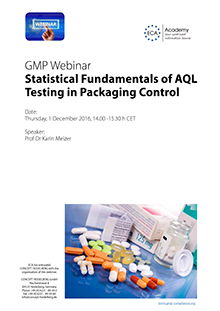Our Service
Costs
This training/webinar cannot be booked. To find alternative dates for this training/webinar or similar events please see the events list by topic.
For many training courses and webinars, there are also recordings you can order and watch any time. You can find these recordings in a list sorted by topic.
Or simply send us your inquiry by using the following contact form.
If you have any questions, please contact us:
Tel.: +49 (0)6221 / 84 44 0 E-Mail: info@gmp-compliance.org
Speakers
Prof Dr Karin Melzer
Karin Melzer received her PhD at the University of Ulm. She worked as an actuary in the insurance industry and is a member of the German Actuarial Society. In 2008 she was appointed as Professor for Mathematics and Statistics at the Esslingen University of Applied SciencesBackground
Usually, the responsibility of ensuring container quality upon delivery to users (e.g. pharmaceutical companies) rests with the manufacturers (suppliers) of packaging materials. However, users are held responsible by regulatory requirements to ensure suitability of containers for their products. Therefore, users should conduct sampling of incoming packaging lots to confirm their acceptability according to predetermined quality agreements.
Expecting defect-free containers from a supplier does not eliminate the need for some degree of incoming and online inspection, as well as post-packaging inspection.
Acceptance sampling of incoming batches by users has its limitations. Care should be taken to understand the “risks” of the sampling plan and the defined defect class / Acceptance Quality Limits (AQLs). Every AQL testing contains the statistical possibility of accepting a lot that is “bad” or rejecting a lot that is “good” (consumer’s and producer’s risk).
Since it is not practical to inspect incoming lots to 100 % and to expect container lots to be free of imperfections, it is important that users and suppliers consistently define sample sizes, attributes and AQLs.
Defect evaluation lists containing sample sizes, defect classes (Critical, Major or Minor), attributes and AQLs can provide such consistency.
In case of critical defects it is important to separate and know the difference between the goal of zero non-conformities and sampling plans where the criteria is Accept on zero, Reject on one.
Quality agreements between manufacturer and user (e.g. pharmaceutical company) should include consistent metrics (AQL specifications) based on the manufacturer´s (supplier´s) production capability and the user´s reasonable expectations.
Target Group
The webinar targets executives and staff from production and quality units (suppliers and users of packaging materials) who are in charge of inspection and quality control of packaging materials.
But also Qualified Persons responsible for the review and release of products are within the target group of this webinar.
Technical Requirements
To be able to take part in a Webinar, you need a computer with high-speed Internet access (i.e. DSL) and speakers. Your Internet browser must have following features to use the GMP Webinar system:
1. Adobe Flash-Player must be installed.
2. Javascript must be allowed.
3. Port 1935 must be released.
Please read the detailed technical requirements in this document:
http://www.gmp-compliance.org/webinar/webinar_requirements.htm
Programme
AQL testing as part of incoming good inspection process is commonly used. But still, questions often arise. It is the webinar’s aim to provide assistance here and to explain statistical fundamentals behind the AQL testing concept.
- Definition of AQL – what does it mean in regard to the accepted lot? What is the level of possible defects?
- How to use defect evaluation lists?
- How are quality levels determined and how is the number of units to be inspected calculated?
- What does AQL testing look like for supplier and user?
- What has to be done when AQL limits are exceeded?
GMP Conferences by Topics
- General Quality Assurance and GMP Compliance Topics
- Hygiene
- General Microbiology Topics
- Regulatory Affairs
- Development
- General Analytics Topics
- Good Distribution Practice
- Sterile Manufacturing
- Computer Validation
- General Qualification/Validation Topics
- General Engineering Topics
- APIs/Excipients
- GMP Basic Training Courses
- Medical Devices and Combination Products
- Packaging and Packaging Material
- Data Integrity
- Qualified Person (QP)
- GMP Auditing
- Documentation
- Cleaning Validation
- General IT Compliance Topics
- Impurities
- OOS / OOE / OOT
- Material Testing
- Validation of Analytical Methods
- Analytical Instrument Qualification
- Stability Testing
- Microbiological Testing
- Technology
- General Manufacturing Topics
- Solid Dosage Forms/Semi-Solid Dosage Forms
- Biotechnology/Blood/ATMP
- Herbal Drug Products/Cannabis/Radiopharmaceuticals
- Others

